Market Overview: Weekend Market Update
The Emini broke above the top of a ledge on the weekly chart. There is a 50% chance that the breakout will fail.
The 30 year treasury bond futures have a weak breakout above the 2016 wedge top. The odds favor a month or two of sideways trading.
The EURUSD weekly chart reversed up from the bottom of a 22 month bear channel this week. However, there is also a 12 week bear channel and it is tight. This makes only a minor reversal up likely.
30 year Treasury Bond Futures market:
Strong rally up to 2016 high
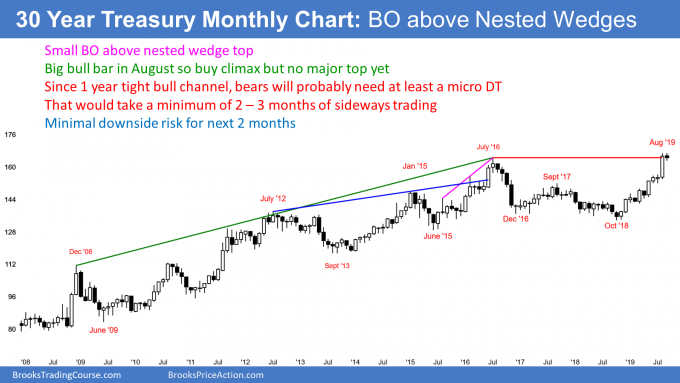
The 30 year treasury bond futures monthly chart has been in a strong bull trend over the past year. The August rally broke slightly above the 2016 wedge top and all-time high.
In general, when there is a breakout above a wedge top, there is a 50% chance of a measured move up and a 50% chance of a reversal down. But a nested wedge top is a reliable pattern. Therefore, there is only a 40% chance of a strong break above the 2016 high, and a much smaller chance of a measured move up. Traders should expect a reversal down within the next 5 months.
Most tops are not abrupt. There will typically be at least a micro double top, like in January 2015, or 3 consecutive bear bars, like after the July 2016 high. That means there is not much downside risk for several months.
Zero interest rates are unlikely
TV pundits are confidently saying that the interest rate will fall to zero, like it has in so many other wealthy countries. While statements like this get a purported expert some time on TV, his lemming logic is foolish. Lots of things sound good on TV, but if you take a minute to think about them, there is often no logical basis for the statement.
This is an example. I am not saying that a negative interest rate is impossible for US treasuries. I am only saying that there is no rational basis for that conclusion. In fact, the monthly 30 year treasury bond chart tells a different story.
Breakout above 9 year wedge top
For over 5 years, I have been saying that the monthly chart rally would continue up to form to a nested wedge top. I carefully chose my words. I repeatedly said that the high would be final high or near the final high for the next 20 years.
That is still the case. The 2019 rally broke above the 2016 top of the 2008 – 2016 wedge in August. This breakout might continue up for another 10% and last for a year or more. But the odds are that the breakout will ultimately fail. A reversal down would be a failed breakout above a wedge, and the implication is the same as for a wedge top.
The wedge rally began with the December 2008 high and has now lasted 11 years. Once there is a reversal, the bear trend will last at least 10 years and probably 20 years. That means interest rates will soon begin to trend higher for a long time.
But as climatic as the August bar was, there is no top yet. Even if September ends up as the final high, the chart will likely have to go sideways for several bars (months) before there is at least a micro double top. That is the minimum traders want to see before they will bet on a reversal down. Even though September is typically not good for bonds, there is not much downside risk for the next couple months.
EURUSD weekly Forex chart:
Sell climax reversing up from bottom of 22 month bear channel
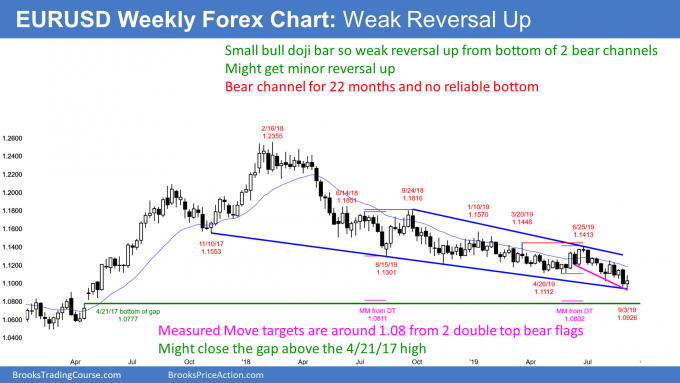
The EURUSD weekly Forex chart formed a bull reversal bar this week. The low poked below the bottom of the bear channel that began 22 months ago in November 2017. It was also a reversal up from the bear channel that began on June 25.
While this week’s candlestick had a bull body, it was small. A doji bar like this is a weak buy signal. This is especially true in a tight bear channel, like the one down from the June 25 high. A rally from a weak setup typically is minor. That means that a bear flag or a bull leg in the bear channel is more likely than a bull trend.
For the past year in the bear channel, every strong rally reversed down from a lower high after a few weeks. In addition, every strong selloff reversed up within a week or two of making a new low.
Price action does not remain constant forever. A year in a tight bear channel is unusual. Consequently, traders expect change soon.
A bear channel is a bull flag
A bear channel behaves like a bull flag 75% of the time. Traders expect a break above the channel and the end of the bear trend. When a bear trend ends, there is usually then a trading range that can last many bars. Less often, a bear trend immediately reverses into a bull trend.
In 25% of bear channels, there is a successful bear breakout below the bear channel and an acceleration down. In 75% of cases when there is a break below the bear channel, the selloff reverses up within 5 bars. When it does, the rally then usually breaks above the bear channel and the channel transitions into a trading range or bull trend.
There is currently no evidence of a breakout above or below the bear channel. As a result, traders will continue to look for reversals every few weeks.
It is important to note that there are magnets below. Two bear flags have measured move projections to just above 1.08. Also, the bottom of the April 2, 2017 gap is just below 1.08. Most gaps get filled, especially if the market gets close. Many traders will not trust a reversal up until after these targets have been reached.
Monthly S&P500 Emini futures chart:
Pullback from breakout above oo buy setup (consecutive outside bars)
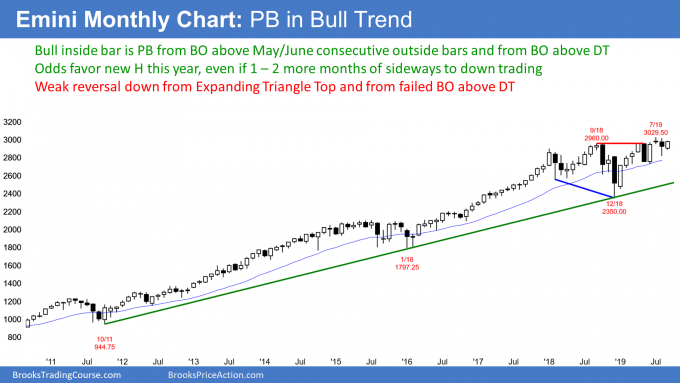
The monthly S&P500 Emini futures chart has a bull inside bar so far in September. I have talked about the oo buy setup since June went above the May high. May was an outside down month and June was outside up. They therefore formed consecutive outside bars in a bull trend.
That is a bull flag. Once July went above the June high, there was a 60% chance that the next 3 months would be sideways to up. September is the 3rd month and the Emini is back at the June high. That was the entry price for the bulls. Consequently, there have been 3 sideways months since the June oo buy signal. That is the minimum objective for the bulls.
Where does the Emini go from here? An oo pattern is an expanding triangle on a lower time frame chart. A triangle is an area of agreement. If the Emini goes above or below, it tends to get drawn back into the triangle. Therefore, a rally from here might only last a few months before it gets pulled back into the triangle.
Emini has expanding triangle top (also called a megaphone or bull horn pattern)
I have mentioned many times over the past 4 months that the monthly chart has a bigger expanding triangle that began with the January 2018 high. It might be easier to see on the weekly chart.
An expanding triangle means that the Emini keeps making new highs and lows, but each one soon reverses. As a result, the Emini monthly chart has a 40% chance of a reversal down to the bottom of the triangle at the December low.
But when? The bulls might continue the rally for a few more months. Any more than that would probably mean that the triangle is no longer significant.
July was the sell signal bar. But it was a small doji. That typically is not strong enough to reverse a strong bull trend. Most traders will want to see a 2nd sell signal.
For example, October or November might become a sell signal bar for a micro double top or a wedge top. If October or November goes above July and reverses, it would be the 3rd leg up from December. The 1st 2 legs were the May and the July highs. If the month is a big bear bar closing near its low, traders would see that as a much more reliable sell signal.
Weekly S&P500 Emini futures chart:
Emini breakout above August ledge top might fail
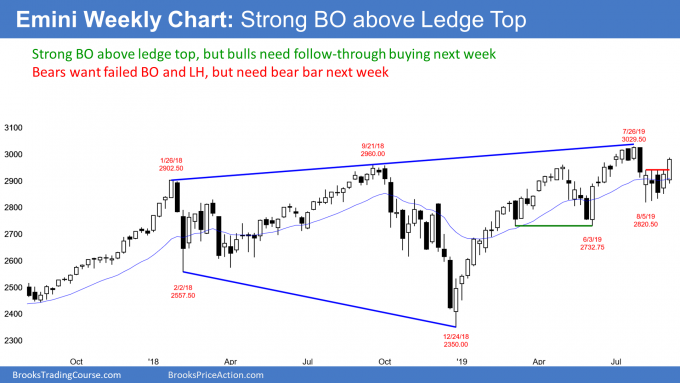
The weekly S&P500 Emini futures chart had been in a tight trading range for 4 weeks prior to this week’s bull breakout. The reason I said that a bull breakout was likely this week is that the trading range had a ledge top.
On a 5 minute Emini chart, a ledge top is 4 or more bars in a tight trading range with exactly the same high. On higher time frame charts, you will never see a perfect ledge. But markets are fractal. That means all time-frames behave the same. Consequently, ledges on daily and weekly charts behave like those on the 5 minute chart, even though the highs are not identical.
What happens after a ledge top?
The closer a ledge is to perfect, the more it will behave like a ledge. The ledge top of the weekly chart is the most perfect one in many years. On a 5 minute chart, there is an 80% chance of a breakout above the ledge.
Furthermore, there is then an 80% chance of a pullback below the top of the ledge. It typically comes within 20 bars, but sometimes not for 100 bars. That pullback sometimes grows into a bear trend.
On the weekly chart, it is impossible to accurately assess the probabilities because ledges are so rare. There is not enough data to calculate reliable statistics. But traders should assume that the odds of the bull breakout and the pullback are still very high.
The bulls got their breakout this week. There will probably be a pullback below the top of the ledge within a few weeks. It could come this week.
If the reversal down is strong, the odds will again shift in favor of a break below the 5 week trading range and below 2800. If the reversal down is weak, it will probably form a bull flag. Traders will then look for a new all-time high within a month or two.
But even if the bears get their reversal down, traders will buy a test of either 2800 or 2700. The monthly chart is still bullish enough to make at least one more new all-time high likely this year, even if there is a selloff to 2700 first.
Daily S&P500 Emini futures chart:
Questionable breakout above 5 week trading range
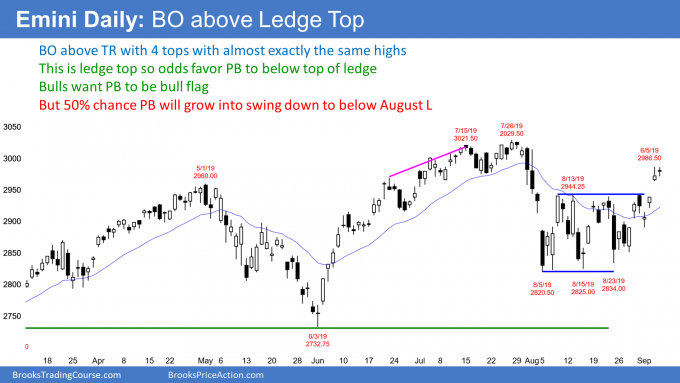
The daily S&P500 Emini futures chart gapped above the top of a 5 week trading range on Thursday. However, the Emini did not form a pair of big bull trend bars closing on their highs. Traders sense that the breakout is not as strong as it could be.
Compare it to the June break above the May bear channel. There were many bull bars closing above their midpoints or near their highs. That led to a strong 2 month rally.
In addition to the lack of big bull bars, there are other problems that reduce the chance of a successful breakout. I mentioned earlier that a break above a ledge top typically soon has a reversal down back below the ledge top. Therefore, even if this breakout continues for a week or two, there will probably be a pullback to below the 2944.25 top of the 5 week trading range.
Also, a trading range is a magnet. It is an area of agreement and it resists breaking out. In general, there is a 50% chance that the 1st strong breakout above a trading range will fail. For example, a gap down next week would create an island top. While an island top typically is a minor sell signal, in the current context, it could lead to a 2nd leg down to 2700 – 2800.
The monthly and weekly charts have an expanding triangle top. That makes many bulls hesitant to buy near the high.
It is important to remember how strong the August selloff was. A selloff that strong usually has as least a small 2nd leg sideways to down. Sometimes there is a strong rally after the 1st leg down, but that rally then reverses down from a lower high and leads to a 2nd leg down.
Testing the July 18 neckline of the double top
On the 5 minute chart, both Thursday and Friday oscillated around the July 18 low of 2975.75. That is the neckline of the July 15 and July 26 double top. If the Emini sells off next week, then the rally from the August low would simply be a breakout test of that low.
The bulls need buying pressure
What do the bulls need to increase the probability of a successful breakout and a rally to a new all-time high? They need buying pressure, which means a sign that the bulls are more aggressive than the bears. That can be one or more big bull bars closing near their highs, several small bull bars, or a small pullback bull trend in a tight bull channel.
At the moment, the bulls have none of this. Until they can demonstrate more strength, traders will assume that this breakout has a 50% chance of forming a lower high and reversing down to 2700 – 2800.
Trading Room
Traders can see the end of the day bar-by-bar price action report by signing up for free at BrooksPriceAction.com. I talk about the detailed Emini price action real-time throughout the day in the BrooksPriceAction.com trading room. We offer a 2 day free trial.
Charts use Pacific Standard Time
When I mention time, it is USA Pacific Standard Time (the Emini day session opens at 6:30 am PST, and closes at 1:15 pm PST). You can read background information on the intraday market reports on the Intraday Market Update page.